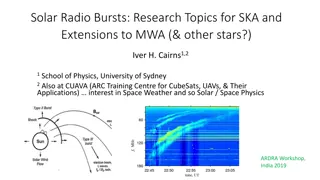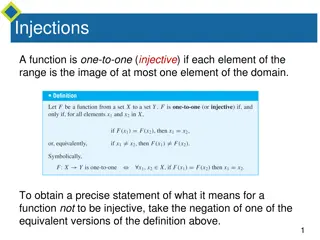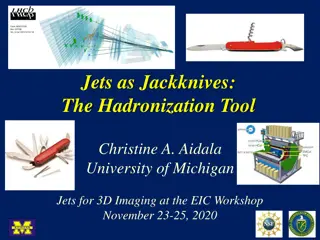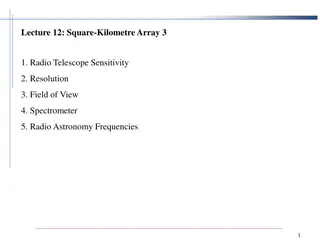Influence of Jet Physics on Radio-Loud AGNs in the Optical Domain
Differences between radio-loud and radio-quiet AGNs in terms of optical properties, including broader Balmer lines, irregular line profiles, Fe II emission, and [O III] emission. The orientation effects and internal extinction in AGNs are also discussed, shedding light on the influence of jet production physics on these phenomena.
Download Presentation

Please find below an Image/Link to download the presentation.
The content on the website is provided AS IS for your information and personal use only. It may not be sold, licensed, or shared on other websites without obtaining consent from the author. Download presentation by click this link. If you encounter any issues during the download, it is possible that the publisher has removed the file from their server.
E N D
Presentation Transcript
Does jet physics influence radio- loud AGNs in the optical? Martin Gaskell Astronomy & Astrophysics University of California Santa Cruz mgaskell@ucsc.edu
What are some radio loud/quiet differences? What are some radio loud/quiet differences? Radio-quiet AGNs ( Seyfert galaxies ) first found in spiral galaxies. (Fath 1908; Campbell & Moore 1918) Powerful radio-loud AGNs ( Radio galaxies ) first found in giant ellipticals (E.g., Cygnus A, Cen A, M87, NGC 1275, Hercules A, Hydra A) (Shklovskii 1961) When broad Balmer lines are visible they are broader and more asymmetric in radio-loud AGNs than radio-quiet AGNs (Osterbrock, Koski & Phillips 1975, 1976; Osterbrock 1977) Radio-quiets have stronger Fe II and shallower Balmer decrements, H /H (Osterbrock 1977) 2
Dependence of optical properties on radio Dependence of optical properties on radio type type Miley & Miller (1979) Found that extended radio source AGNs have: Broader Balmer lines More irregular Balmer line profiles Weaker Fe II emission Stronger narrow [O III] emission (greater equivalent widths and higher [O III]/H ratio.) BIG QUESTION: are these differences between radio loud/quiet AGNs and between compact vs. extended, a consequence of jet production physics, or are they caused by other factors? 3
Orientation effects Orientation effects Blandford & Rees (1978): proposed that BL Lacs have jets aimed at us (BIG ADVANCE!) Blandford & Konigl (1979): proposed that compact radio sources are jets aimed at us Keel (1980): Discovered that AGNs with broad lines visible ( type-1 AGNs) are preferentially face-on (ANOTHER BIG ADVANCE) proposed that AGNs surrounded by dust in the equatorial direction now standard orientation-unification model. Wills and Browne (1986): width of Balmer lines is correlated with orientation (broader in more edge-on objects) BLR is flattened The same BLR seen from different viewing angles (face-on and 30o tilt) (Gaskell 2011): 4
Internal extinction in AGNs Internal extinction in AGNs Long controversial because of (a) doubts over whether broad hydrogen line ratios had Case B theoretical ratios (Osterbrock & Parker 1965) and (b) lack of reddening in the UV and lack of the 2175 feature (McKee & Petrosian 1974). Solution: Gaskell et al. (2004) Compared AGNs of different inclinations (i.e., different reddenings). Discovered that AGNs have flat reddening curves. Closed symbols: from the continua Open circles: from broad lines 5
Hydrogen line ratios are close to Case B values Hydrogen line ratios are close to Case B values Gaskell (2017) Ratios are close to theoretical Case B. Gaskell et al. (2022) Hydrogen line and non-hydrogen-line reddening indicators (lines and continuum) agree. 6
Selection effects Selection effects Under orientation unification (see Antonucci 1995), type-1 objects (BLR visible) seen within 40o of face-on. Radio-quiet AGNs mostly color selected (e.g., SDSS see Richards et al. 2002) produces a strong bias to low reddening (E(B-V) 0.18 for SDSS) and face-on AGNs (broad lines symmetrical and single-peaked) Radio-loud AGNS radio selected higher reddening (E(B-V) > 0.3) higher inclinations broader lines 7
Why irregular broad Why irregular broad- -line profiles? line profiles? Gaskell & Harrington (2018) Due to partial obscuration of the BLR by compact dust clouds. More common in radio-louds because they are more likely to be at higher inclination. 8
Why narrow lines look stronger in radio Why narrow lines look stronger in radio- -loud AGNs loud AGNs AGN dust is mostly between the BLR and narrow-line region (NLR) (Heard & Gaskell 2016). NLR sticks out above most of the dust. We predict therefore that as reddening increases, [O III] 5007 gets stronger relative to the BLR and to the continuum (= accretion disk + starlight) (Heard & Gaskell 2016) 9
Fe Fe II Fe II comes from the outermost part of the BLR next to the surrounding dust and is correlated with L/LEdd (Gaskell et al. 2022a) Strong jets need massive black holes. In the nearby universe, massive black holes reside in ellipticals and have mostly finished accretion ( downsizing ). Hence have low L/LEdd weaker Fe II. 10
CONCLUSIONS CONCLUSIONS The apparent optical spectral differences between radio-loud and radio-quiet AGNs, and between extended and compact sources are due to 1. Selection effects 2. Orientations effects 3. Differences in reddening 4. Downsizing Searches for possible real intrinsic differences in the optical/UV properties of radio-loud vs. radio-quiet AGNs must allow for these effects. NOTHING YET THAT REQUIRES JET FORMATION TO INFLUENCE THE OPTICAL SPECTRUM. 11

























